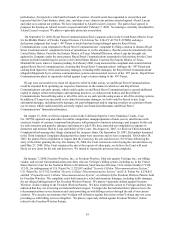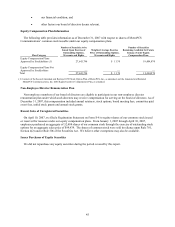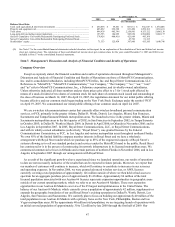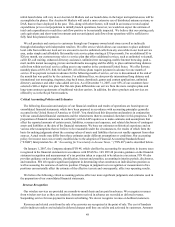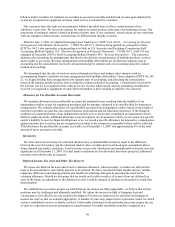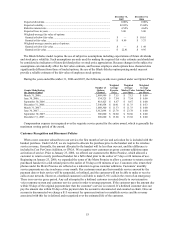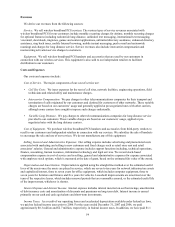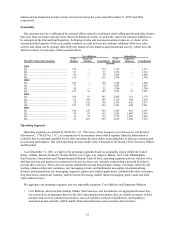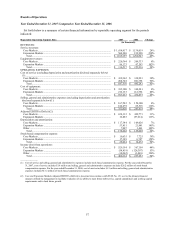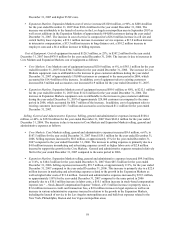Metro PCS 2007 Annual Report Download - page 60
Download and view the complete annual report
Please find page 60 of the 2007 Metro PCS annual report below. You can navigate through the pages in the report by either clicking on the pages listed below, or by using the keyword search tool below to find specific information within the annual report.49
billed to indirect retailers for handsets are recorded as accounts receivable and deferred revenue upon shipment by
us and are recognized as equipment revenues when service is activated by customers.
Our customers have the right to return handsets within a specified time or after a certain amount of use,
whichever occurs first. We record an estimate for returns as contra-revenue at the time of recognizing revenue. Our
assessment of estimated returns is based on historical return rates. If our customers’ actual returns are not consistent
with our estimates of their returns, revenues may be different than initially recorded.
Effective July 1, 2003, we adopted Emerging Issues Task Force (“EITF”) No. 00-21, “Accounting for Revenue
Arrangements with Multiple Deliverables,” (“EITF No. 00-21”), which is being applied on a prospective basis.
EITF No. 00-21 also supersedes certain guidance set forth in U.S. Securities and Exchange Commission Staff
Accounting Bulletin Number 101, “Revenue Recognition in Financial Statements,” (“SAB 101”). SAB 101 was
amended in December 2003 by Staff Accounting Bulletin Number 104, “Revenue Recognition.” The consensus
addresses the accounting for arrangements that involve the delivery or performance of multiple products, services
and/or rights to use assets. Revenue arrangements with multiple deliverables are divided into separate units of
accounting and the consideration received is allocated among the separate units of accounting using the residual
method of accounting.
We determined that the sale of wireless services through our direct and indirect sales channels with an
accompanying handset constitutes revenue arrangements with multiple deliverables. Upon adoption of EITF No. 00-
21, we began dividing these arrangements into separate units of accounting, and allocating the consideration
between the handset and the wireless service using the residual method of accounting. Consideration received for
the wireless service is recognized at fair value as service revenue when earned, and any remaining consideration
received is recognized as equipment revenue when the handset is delivered and accepted by the customer.
Allowance for Uncollectible Accounts Receivable
We maintain allowances for uncollectible accounts for estimated losses resulting from the inability of our
independent retailers to pay for equipment purchases and for amounts estimated to be uncollectible for intercarrier
compensation. We estimate allowances for uncollectible accounts from independent retailers based on the length of
time the receivables are past due, the current business environment and our historical experience. If the financial
condition of a material portion of our independent retailers were to deteriorate, resulting in an impairment of their
ability to make payments, additional allowances may be required. In circumstances where we are aware of a specific
carrier’ s inability to meet its financial obligations to us, we record a specific allowance for intercarrier compensation
against amounts due, to reduce the net recognized receivable to the amount we reasonably believe will be collected.
Total allowance for uncollectible accounts receivable as of December 31, 2007 was approximately 8% of the total
amount of gross accounts receivable.
Inventories
We write down our inventory for estimated obsolescence or unmarketable inventory equal to the difference
between the cost of inventory and the estimated market value or replacement cost based upon assumptions about
future demand and market conditions. Total inventory reserves for obsolescent and unmarketable inventory were not
significant as of December 31, 2007. If actual market conditions are less favorable than those projected, additional
inventory write-downs may be required.
Deferred Income Tax Asset and Other Tax Reserves
We assess our deferred tax asset and record a valuation allowance, when necessary, to reduce our deferred tax
asset to the amount that is more likely than not to be realized. We have considered future taxable income, taxable
temporary differences and ongoing prudent and feasible tax planning strategies in assessing the need for the
valuation allowance. Should we determine that we would not be able to realize all or part of our net deferred tax
asset in the future, an adjustment to the deferred tax asset would be charged to earnings in the period we made that
determination.
We establish reserves when, despite our belief that our tax returns are fully supportable, we believe that certain
positions may be challenged and ultimately modified. We adjust the reserves in light of changing facts and
circumstances. Our effective tax rate includes the impact of income tax related reserve positions and changes to
income tax reserves that we consider appropriate. A number of years may elapse before a particular matter for which
we have established a reserve is finally resolved. Unfavorable settlement of any particular issue may require the use
of cash or a reduction in our net operating loss carryforwards. Favorable resolution would be recognized as a






